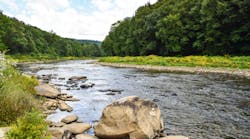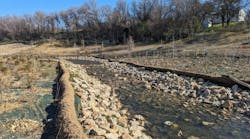Nicknamed “Hub City,” Colton, California is home to the Colton Crossing, which was built in 1833 and was one of the busiest at-grade railroad crossings in the United States. Fast forward to the modern-day. Less than two miles south of the original Colton Crossing, on the Santa Ana River bank, are two developing industrial buildings. Placed between the I-10 and I-215 freeways, these buildings offer direct access to San Diego and Los Angeles Counties, and the site is directly adjacent to the Santa Ana River. The proximity to one of the largest rivers in Southern California poses the undeniable need to treat stormwater from the 16-acre site, which will house over 200,000 square feet of warehouse space.
Challenge
Commerce and traffic will dominate this new development's surface, leaving limited space for largescale stormwater systems. Furthermore, Colton's land premiums are a driving force to obtain stormwater solutions within a minimal footprint. Tricky soil conditions and the need to address pollutants of concern, such as oil, grease, total suspended solids (TSS), trash, debris, metals, and pathogens, along with meeting the regulations of the Santa Ana Regional Water Quality Board NPDES Permit and County of San Bernardino Water Quality Management Plan, are not easy feats.
Solution
The UrbanPond, a traffic-rated underground stormwater storage system, was designed and produced with considerations such as height of cover, live and dead loads, proximity to adjacent structures, and required detention volume. This land-saving precast storage system allows for development above grade while providing stormwater storage below grade. Ultimately resulting in a traffic-rated configuration within a minimal surface footprint, saving land, money and time.
In addition, upstream of the 156 UrbanPond Modules and 37 LinkUP slabs is a hydrodynamic separator, which spearheads this treatment train design. The 5’x’10’ DSBB Separator reduces flow velocity and separates floatables like trash, debris, and oil; and settleable particles such as sediment. This pretreats the stormwater and supports the entire connected systems' efficiency and long-term maintenance costs. The DSBB Separator is verified by NJCAT, NJDEP certified, and Full Capture approved by the California State Water Resources Control Board.
Downstream of the UrbanPond System are three 10'x20' Modular Wetland Linear units. Modular Wetlands provides the highest level of stormwater treatment and is the only* biofiltration product that can be placed downstream of a detention system.
The Modular Wetlands is TAPE GULD approved by Washington Department of Ecology and a CA Full Capture device known for its superior pollutant removal. The Modular Wetlands will treat downstream flows from the UrbanPond for TSS, heavy metals, hydrocarbons, and more.
Conclusion
This stormwater project in Colton represents the ability to engineer a creative treatment train system that satisfies local regulations while meeting unique challenges and site constraints. Bio Clean is always eager to build partnerships with our clients, delivering efficient treatment and storage configurations, and offering an in-house engineering team to create the best solutions for their sites.
The Modular Wetlands Linear (MWS Linear) is the only biofilter utilizing horizontal flow. This proprietary design gives the Modular Wetlands Linear the unique ability to accommodate and adjust to the necessary depth of an outflow pipe on a detention system, and it is approved under Washington State Ecology, without plants (for underground or traffic rated designs).
View downloadable PDF version.
Editor's Note: Scranton Gillette Communications and the SGC Water Group are not liable for the accuracy, efficacy and validity of the claims made in this piece. The views expressed in this content do not reflect the position of the editorial teams of Water & Wastes Digest, Water Quality Products and Storm Water Solutions.






